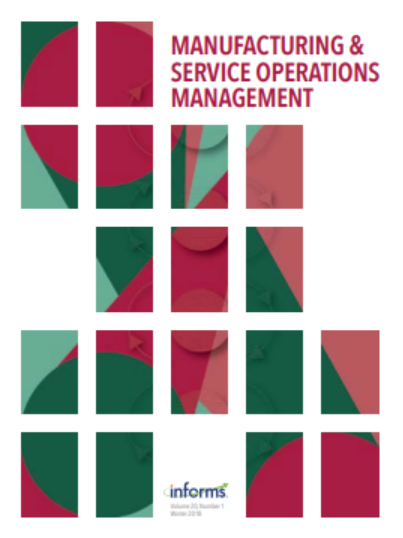Incentivizing Commuters to Carpool: A Large Field Experiment with Waze
IF 4.8
3区 管理学
Q1 MANAGEMENT
M&som-Manufacturing & Service Operations Management
Pub Date : 2023-07-01
DOI:10.1287/msom.2021.1033
引用次数: 3
Abstract
Problem definition: Traffic congestion is a serious global issue. A potential solution, which requires zero investment in infrastructure, is to convince solo car users to carpool. Academic/practical relevance: In this paper, we leverage the Waze Carpool service and run the largest ever digital field experiment to nudge commuters to carpool. Methodology: Our field experiment involves more than half a million users across four U.S. states between June 10 and July 3, 2019. We identify users who can save a significant commute time by carpooling through the use of a high-occupancy vehicle (HOV) lane, users who can still use an HOV lane but have a low time saving, and users who do not have access to an HOV lane on their commute. We send them in-app notifications with different framings: mentioning the HOV lane, highlighting the time saving, emphasizing the monetary welcome bonus (for users who do not have access to an HOV lane), and a generic carpool invitation. Results: We find a strong relationship between the affinity to carpool and the potential time saving through an HOV lane. Managerial implications: Specifically, we estimate that mentioning the HOV lane increases the click-through rate (i.e., proportion of users who clicked on the button inviting them to try the carpool service) and the onboarding rate (i.e., proportion of users who signed up and created an account with the carpool service) by 133%–185% and 64%–141%, respectively, relative to a generic invitation. We conclude by discussing the implications of our findings for carpool platforms and public policy. History: This paper has been accepted as part of the 2021 Manufacturing & Service Operations Management Practice-Based Research Competition. Supplemental Material: The online appendix is available at https://doi.org/10.1287/msom.2021.1033 .激励通勤者拼车:Waze的大型实地试验
问题定义:交通拥堵是一个严重的全球性问题。一个不需要基础设施投资的潜在解决方案是说服独自驾车的用户拼车。学术/实践意义:在本文中,我们利用Waze拼车服务,并进行了有史以来最大的数字现场实验,以推动通勤者拼车。方法:我们的现场实验涉及2019年6月10日至7月3日期间美国四个州的50多万用户。我们确定了可以通过使用高载客量车辆(HOV)车道拼车而节省大量通勤时间的用户,仍然可以使用高载客量车辆(HOV)车道但节省时间较少的用户,以及在通勤时无法使用高载客量车辆车道的用户。我们向他们发送不同框架的应用内通知:提到HOV车道,强调节省时间,强调金钱欢迎奖励(对于没有HOV车道的用户),以及通用的拼车邀请。结果:我们发现拼车的亲和力与通过HOV车道节省的潜在时间之间存在很强的关系。管理意义:具体来说,我们估计,与普通邀请相比,提到HOV车道会使点击率(即点击邀请按钮的用户比例)和入车率(即注册并创建拼车服务账户的用户比例)分别提高133%-185%和64%-141%。最后,我们讨论了我们的发现对拼车平台和公共政策的影响。历史:本文已被接受为2021年制造业&服务营运管理实务研究比赛。补充材料:在线附录可在https://doi.org/10.1287/msom.2021.1033上获得。
本文章由计算机程序翻译,如有差异,请以英文原文为准。
求助全文
约1分钟内获得全文
求助全文
来源期刊

M&som-Manufacturing & Service Operations Management
管理科学-运筹学与管理科学
CiteScore
9.30
自引率
12.70%
发文量
184
审稿时长
12 months
期刊介绍:
M&SOM is the INFORMS journal for operations management. The purpose of the journal is to publish high-impact manuscripts that report relevant research on important problems in operations management (OM). The field of OM is the study of the innovative or traditional processes for the design, procurement, production, delivery, and recovery of goods and services. OM research entails the control, planning, design, and improvement of these processes. This research can be prescriptive, descriptive, or predictive; however, the intent of the research is ultimately to develop some form of enduring knowledge that can lead to more efficient or effective processes for the creation and delivery of goods and services.
M&SOM encourages a variety of methodological approaches to OM research; papers may be theoretical or empirical, analytical or computational, and may be based on a range of established research disciplines. M&SOM encourages contributions in OM across the full spectrum of decision making: strategic, tactical, and operational. Furthermore, the journal supports research that examines pertinent issues at the interfaces between OM and other functional areas.
 求助内容:
求助内容: 应助结果提醒方式:
应助结果提醒方式:


